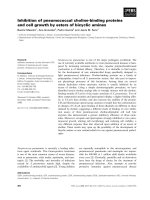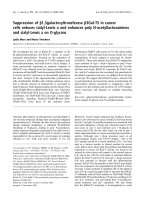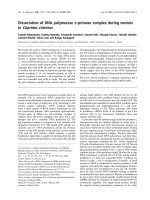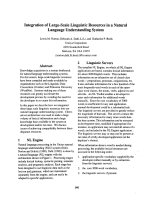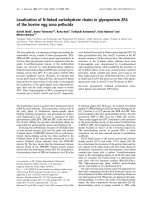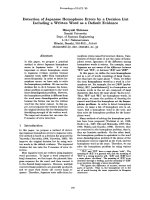báo cáo khoa học: "Detection of DNA mismatch repair proteins in fresh human blood lymphocytes - towards a novel method for hereditary non-polyposis colorectal cancer (Lynch syndrome) screening" doc
Bạn đang xem bản rút gọn của tài liệu. Xem và tải ngay bản đầy đủ của tài liệu tại đây (402.9 KB, 7 trang )
RESEARCH Open Access
Detection of DNA mismatch repair proteins in
fresh human blood lymphocytes - towards a
novel method for hereditary non-polyposis
colorectal cancer (Lynch syndrome) screening
Samar Hassen
1,2
, Bruce M Boman
3*
, Nawab Ali
1,2
, Marcie Parker
3
, Chandra Somerman
3
, Zohra J Ali-Khan Catts
3
,
Akhtar A Ali
1,2†
and Jeremy Z Fields
1†
Abstract
Background: A broad population-based assay to detect individuals with Lynch Syndrome (LS) before they develop
cancer would save lives and healthcare dollars via cancer prevention. LS is caused by a germline mutation in a
DNA mismatch repair (MMR) gene, especially protein truncation-causing mutations involving MSH2 or MLH1.We
showed that immortalized lymphocytes from LS patients have reduced levels of full-length MLH1 or MSH2
proteins. Thus, it may be feasible to identify LS patients in a broad population-based assay by detecting reduced
levels of MMR proteins in lymphocytes.
Methods: Accordingly, we determined whether MSH2 and MLH1 proteins can also be detected in fresh
lymphocytes. A quantitative western blot assay was developed using two commercially available monoclonal
antibodies that we showed are specific for detecting full-length MLH1 or MSH2. To directly determine the ratio of
the levels of these MMR proteins, we used both antibodies in a multiplex-type western blot.
Results: MLH1 and MSH2 levels were often not detectable in fresh lymphocytes, but were readily detectable if
fresh lymphocytes were first stimulated with PHA. In fresh lymphocytes from normal controls, the MMR ratio was
~1.0. In fresh lymphocytes from patients (N > 50) at elevated risk for LS, there was a bimodal distribution of MMR
ratios (range: 0.3-1.0).
Conclusions: Finding that MMR protein levels can be measured in fresh lymphocytes, and given that cells with
heterozygote MMR mutations have reduced levels of full-length MMR proteins, suggests that our immunoassay
could be advanced to a quantitative test for screening populations at high risk for LS.
Keywords: Lynch Syndrome, Hereditary Cancer, MMR proteins, HNPCC, MLH1, MSH2, Lymphocytes, PHA treatmen t,
Western blotting, Cell Culture
Background
Colorectal cancer is the second most common cause of
cancer deaths in western countries including the US. It
was responsible for 9% of new cancer cases and 10% of
cancer deaths in 2010 in the US [1,2]. Hereditary non-
polyposis colorectal cancer (HNPCC), or Lynch Syndrome
(LS), is the most common form of hereditary colorectal
cancer, accounting for 5-10% of all colon cancers. HNPCC
is an autosomal dominant genetic disorder that is caused
by an inherited germline mutation in a DNA mismatch
repair (MMR) gene [3].
The mismatch repair system consists of several nuclear
proteins that are responsible for maintaining genetic
stability by repairing base-to-base mismatches and inser-
tion/deletion loops that arise during S phase. The inacti-
vation of this system causes genomic instability and a
predisposition to cancer [4]. Therefore, colon cancers
from LS patients often exhibit microsatellite instability
* Correspondence:
† Contributed equally
3
Helen F Graham Cancer Center, Newark DE 19713, USA
Full list of author information is available at the end of the article
Hassen et al. Journal of Experimental & Clinical Cancer Research 2011, 30:100
/>© 2011 Hassen et al; licensee BioMed Central Ltd. This is an Open Access article distributed under the terms of the Creative Commons
Attribution License ( which permits unrestricted use, distribution, an d reproduction in
any medium, provided the original work is properly cited.
[5]. Mutations in four genes are primarily responsible for
LS: MLH1, MSH2, MSH6, and PMS2.
Seventy percent of HNPCC families identified on the
basis of family history criteria have a germline mutation
in an MMR gene. About 80% of these MMR mutations
are found in the MLH1 and MSH2 genes, 10% in MSH6,
and < 5% in PMS2 [6]. The majority of germline MMR
DNA mutations lead to a truncated protein product.
One problem with identifying LS is that often the diag-
nosis occurs only after the affected individual develops
cancer. Another issue with detecting LS is that the cur-
rently available tests for detecting DNA MMR protein
abnormalities are based on DNA sequencing, an expe n-
sive, time consuming process available mainly at commer-
cial laboratories. To address this prob lem, we considered
the development of a practical immunoassay based on the
theoretical consideration that protein expressio n follows
gene dosage. We previously showed [7] that immortalized
lymphocytes from LS patients have a reduced level of their
corresponding full length MMR protein, either MLH1 or
MSH2. In the current study we determined whether
MSH2 and MLH1 protein s can also be detected in fresh
lymphocytes, which would make any population based
assay more practical. Showing that one can determine the
levels of MLH1 and MSH2 in lymphocytes from fresh
blood samples could be the basis for developing a popula-
tion-based screening method that more accurately detects
LS trait carriers before they develop cancer. To establish
proof of principle for this assay, we analyzed fresh blood
samples from a population of individuals who are at high
risk for having a germline MMR mutation
Methods
Materials
Human colorectal cancer cell lines (SW480, LoVo,
HCT116), culture media (RPMI-1640, MEM, F-12 K),
Fetal Bovine Serum (FBS), Trypsin/EDTA and antibiotics
were purchased from American Type Culture Collecti on
(ATCC). Antibodies were from the commercial sources
indicated (Table 1). M-PER mammalian protein extraction
reagent was from Pierce Biotechnology. Anti-mouse-IgG-
HRP conjugated detection antibody, protease inhibitor
cocktail, PMSF, 2-mercaptoethanol, PHA, penicillin, and
streptomycin were from Sigma-Aldrich. Lymphoprep was
from Axis-Shield. Human IL-2 was a gift from Dr. Martin
Cannon, University of Arkansas for Medical Sciences,
Little Rock, AR.
Isolation of Lymphocytes
After IRB approval and signed informed consent, venous
blood was collected from patients using EDTA-contain-
ing vacutainer tubes. Samples were co llected from indivi-
duals undergoing genetic counseling for heredita ry colon
cancer in the Familial Cancer Clinic at the Helen F
Graham Cancer Center, Christiana Care Health System
(Newark DE). Samples were de-identified and processed
within 24 hours to isolate lymphocytes. Lymphocytes
were separated by density gradient centrifugation using
Lymphoprep. Briefly, blood samples were diluted 2-fold
with PBS, pH 7.4. An aliquot of 20 ml diluted blood was
layeredover15mlofLymphoprepin50mlFalconcen-
trifuge tubes and centrifuged at 1000 g for 20 min at
room temperature in a Sorvall RC 6 Plus centrifuge using
an SH 3000 swinging bucket rotor. Lymphocytes were
harvested from the buffy coat; monocytes from the
plasma layer. Lymphocytes were diluted 3-fold with PBS
(pH 7.4), washed by centrifugation at 350 g, and washed
twice more at 300 g (5 min each), at room temperature.
Lymphocytes were counted by Trypan blue staining and
cultured (1 × 10
6
cells/ml RPMI-1 640 medium). The
lymphocyte yield was ~1 × 10
6
cells per ml of blood.
Cell Culture
Lymphocytes were cultured in RPMI-1640 medium sup-
plemented with 10% FBS, 1% penicillin/streptomycin,
5 mM 2-mercaptoethanol and 10 ul/ml human-IL-2 at
37°C in a 5% CO
2
atmosphere. Immortalized lymphocytes
were grown in the same medium as fresh lymphocytes but
without 2-mercaptoethanol and human-IL-2. Human
colon cancer cell lines (SW480, LoVo, HCT116) were cul-
tured and maintained using established procedures
(ATCC).
Stimulation with PHA
To enhance the expression of MMR proteins, lymphocytes
were stimulated with a mitogen, PHA. Cell lysates were
then prepared. For optimized expression of MLH1 and
MSH2 proteins, fresh blood lymphocytes were routinely
stimulated with 10 ug PHA for 48 hrs.
Western blotting
Cell lysates were prepared in M-PER Mammalian protein
extraction reagent containing protease inhibitor cocktail
and following the manufacturer’s i nstructions. Protein
concentrations were determined by colorimetry [8].
Western blotting was done as described previously [9].
For simultaneous detection of MLH1 and MSH2, a combi-
nation of anti-hMSH2 (Ab-2) and hMLH1 monoclonal
antibodies from Calbiochem and BD Pharmingen, respec-
tively, were used at 1:1000 dilution in the same western
blot.
Densitometry Analysis
Density of the bands of i nterest on a western blot was
determined by scanning of the x-ray film and highlighting
the band area using a BioRad Gel 2000 documentation
sys tem and its softwar e. The actual density of each band
was the value obtained after subtracting the background
Hassen et al. Journal of Experimental & Clinical Cancer Research 2011, 30:100
/>Page 2 of 7
taken from the same x-ray film with an equivalent area.
Ratios between MLH1 and MSH2 were used to compare
variations among patient samples. The smaller of the two
values, MLH1 or MSH2, always became the numerator;
the larger became the denominator. Thus, the smaller the
ratio is relative to 1.0, the greater the decrease of the pro-
tein in the numerator with respect to the level of protein
in the denominator.
Results
To develop an immunoassay that is accurate, we screened
a number of commercially available monoclonal and poly-
clonal antibodies (Table 1) using western blotting to detect
full-length MLH1 and MSH2 proteins in cell lysates from
established colorectal carcinoma cell lines. The results for
polyclonal antibodies were inconsistent. Most polyclonal
antibodies did not show sufficient specificity to be used for
measur ing MLH1 and MSH2 levels. Those that did work
did not produce consistent results; thus, we were unable
to use them for quantitative detection of these proteins
(data not shown). However, we found that two of the
monoclonal antibodies (No. 1 and 2 in Table 1) can quan-
titatively detect full-length MLH1 and MSH2 proteins and
which could be combined in a multiplex fashion to detect
both proteins in a single assay.
Figure 1A shows that both hMLH1 (80 kDa) and
hMSH2 (100 kDa) proteins were detected on the same
blot using a mixture of monoclonal anti-MLH1 and anti-
MSH2 antibodies (mAbs) that specifically detect one or
the other of these proteins. Colorectal adenocarcinoma
cell lines - SW480, HCT116 and LoVo - were used as
positive controls. SW480 expresses both full length
MLH1 and MSH2; HCT116 expresses only full length
MSH2; LoVo expresses only full length MLH1. These
antibodies detected these proteins in a concentration
dependent manner in dilution experiments using SW480
cells that contain both MLH1 and MSH2; the limit of
detection was 10 ug of total cellular protein (Figure 1B).
These antibodies also detected these proteins in a
concentration dependent manner using a mixture of
LoVo and HCT116 cell lysates when the lysates from
these cell lines were mixed together in varying propor-
tions (Figure 1C).
To detect these MMR proteins and determine their ratio
in lymphocytes from fresh human blood samples, we iso-
lated lymphocytes and treated them under the conditions
described in Materials and Methods. Baseline level s of
MLH1 and MSH2 protein were often not detectable in
fresh lymphocytes using western blot assays. Howeve r,
when these lymphocytes were cultured with phytohemag-
glutinin (PHA), a mitogen, t he expression of MLH1 and
MSH2 increased in a dose- and time-dependent manner,
making levels of these MMR proteins readily detectable in
fresh lymphocytes (Figure 2A). MLH1 and MSH2 levels
increased equally after stim ulation by PHA (Figure 2B).
MLH1 and MSH2 were readily detectable in immortalized
lymphocytes and PHA treatment did not affect the expres-
sion of these proteins (Figure 2C). Mor eover, PHA treat-
ment of isolated, fresh monocytes did not enhance MSH2
and MLH1 expression.
Analysis of fresh lymphocytes (PHA treated) from a
cohort of patients (N > 50 subjects) at high risk for LS,
showed a bimodal distribution of MMR ratios (see histo-
gram in Figure 3). The ratios ranged from 0.3 to 1.0 and
peaks (mean ± SDE) wer e at 0.97 ± 0.02 and 0.81 ± 0.08.
Stratification of results (shown as a scatter plot in Figure 3)
Table 1 Commercially available monoclonal and polyclonal antibodies used for detection of MLH1 and MSH2 proteins
on western blots
No. Names Catalog Number Company
Monoclonal Antibodies
1 Anti-MSH2(Ab-2) mouse mAb(FE11) NA27 EMD Calbiochem, Gibbstown, NJ
2 MLH1 554073 BD Pharmingen, San Diego, CA
3 Anti-MSH2(Ab-1)mouse mAb(GB12) NA26T Calbiochem, San Diego, CA
4 Anti-MLH1(Ab-1)mouse mAb(14) NA28 Calbiochem, San Diego, CA
5 MLH1 Sc-56159 Santa Cruz, Santa Cruz, CA
6 MLH1 Sc-56161 Santa Cruz, Santa Cruz, CA
7 MSH2 Sc-56163 Santa Cruz, Santa Cruz, CA
8 MSH2 556349 BD Pharmingen, San Diego, CA
Polyclonal Antibodies
1 MLH1(N-20) Sc-581 Santa Cruz, Santa Cruz, CA
2 MSH2 (N-20) Sc-494 Santa Cruz, Santa Cruz, CA
3 Anti-MSH2 (Ab-3) Pc57 Calbiochem, San Diego, CA
4 Anti-MLH1 (Ab-2) Pc56 Calbiochem, San Diego, CA
5 Rabbit anti-MSH2 A300-020A Bethyl Labs, Montgomery, TX
6 MLH1 2549.00.02 Sdix, Newark, DE
Hassen et al. Journal of Experimental & Clinical Cancer Research 2011, 30:100
/>Page 3 of 7
shows that the MLH1 protein level is substantially reduced
("plus” symbols) in some fresh lymphocyte samples and
MSH2 is reduced ("diamond” symbols) in other samples.
In contrast, analysis of PHA stimulated fresh lymphocytes
from normal controls revealed an MMR ratio close to 1.0
(Table 2). Analysis of normal controls and SW480 cells
shows that the assay is highly reproducible (overall mean ±
SDE = 0.96 ± 0.03). A bimodal distributi on was not seen
for normal healthy control subjects.
Discussion
A main finding of this study is that levels of MMR pro-
teins can readily be measured in lymphocytes from fresh
blood samples if the lymphocytes are firs t stimulated to
Figure 1 Det ection of MLH1 and MSH2 proteins us ing combined MLH1 and MSH2 monoclonal antibodies on the same bl ot. (A)
HCT116 and LoVo cells were used as controls for the absence and presence of MLH1 and MSH2 proteins, respectively, whereas SW480 cells
were used for the presence of both these proteins. There was no apparent cross-reactivity. (B) Different concentrations of SW480 cell extracts
were used for western blotting to establish simultaneous detection of both proteins. Results indicated that the combined antibodies were able
to specifically detect their respective antigens in a dose dependent manner. MLH1 and MSH2 proteins could be detected in samples containing
as little as 10 ug of total cell protein. (C) Detection of MLH1 and MSH2 proteins on western blots with a mixture of varying amounts of HCT116
and LoVo cell lysates. Results show that the combinations of these two monoclonal antibodies were able to detect MLH1 and MSH2 proteins
even when these proteins were present in a sample in different proportions.
Hassen et al. Journal of Experimental & Clinical Cancer Research 2011, 30:100
/>Page 4 of 7
proliferate by PHA. This supports our idea that a practi-
cal immunoassay f or MMR prote ins can b e developed
and used to screen for patients affected with the LS trait
before they develop cancer. These findings are consis-
tent with results from our prev ious study [7] in which
we assayed immortalized lymphocytes.
Our ass ay using two monoclonal antibodies appears to
be specific because it accurately detects MLH1 and
MSH2 in control cell lines that contain one or the other
or both of these proteins (Figure 1A) and the assay also
detects MLH1 and MSH2 proteins in mixing experi-
ments where these proteins are present in varying
Figure 2 Expression of MLH1 and MSH2 proteins in fresh blood and in immortalized lymphocytes following PHA stimulation. (A) Time-
dependent stimulation of MLH1 and MSH2 proteins in fresh blood lymphocytes following PHA treatment. The expression of MLH1 and MSH2
proteins increased in a time dependent manner. These proteins were often not detectable without PHA stimulation. (B) Dose response of fresh
lymphocytes to PHA. Lymphocytes were stimulated with the indicated concentrations of PHA for 48 hrs. The expression of MLH1 and MSH2
proteins in fresh blood lymphocytes increased in a dose-dependent manner. (C) Dose response of immortalized lymphocytes to PHA. There was
no effect of PHA on immortalized lymphocytes. MLH1 and MSH2 proteins were detectable even without PHA stimulation.
Hassen et al. Journal of Experimental & Clinical Cancer Research 2011, 30:100
/>Page 5 of 7
proportions (Figure 1C). Our immunoassay also appears
to be sensitive since it will detect MLH1 and MSH2
proteins in a sample from SW480 cells that contains as
little as 10 ug of cellular protein (Figure 1B). Moreover,
our assay appears to have an acceptable level of preci-
sion in that it is highly reproducible (Table 2).
The fact that MLH1 and MSH2 are not readily
detected in untreated fresh lymphocytes or monocytes is
likely due to the fact that they are not rapidly proliferat-
ing. This is supported by the fact that MLH1 and MSH2
are detectable in immortalized lymphocytes [7], which
are proliferative cells by virtue of the fact that the y have
been transfected with an attenuated Epstein Barr Virus
(EBV) and PHA treatment has little affect on MLH1 and
MSH2 levels in these already proliferative cells. It should
be noted that colon cancer cell lines (e.g., SW480) are
also proliferating cells and have readily detectable le vels
of MMR proteins. The importance of our finding that
PHA stimulation makes MLH1 and MSH2 detectable in
fresh lymphocytes has relevance to the development of a
practical immunoassay for the identification of carriers of
an LS trait in a population-based setting.
A second finding is that the distribution of MMR ratios
among individuals in a genetic counseling program, which
includes carriers of an LS trait, was bimodal (Figure 3)
with one peak close to 1.0 (less likely to be affected) and
another lower than 1.0 (more likely to be affected). A
bimodal distribution was not seen for healthy controls.
This suggests that a subpopulation within the cohort of
individuals at high risk for LS has substantially reduced
levels of one of the two MMR proteins, which is what we
predicted. This finding is consistent with our previous ret-
rospective study [7] that also found a bimodal distribution.
That earlier study was done using immortalized lympho-
cytes and involved individuals with a known MMR geno-
type, those who carried the LS trait and those who did not.
Our findings are consistent with other stu dies [10,11]
that report microsatellite instability (MSI) in lymphocytes
from LS patients - including ones with germline MSH2
or MLH1 mutations. I f lymphocytes from LS patie nts
have MSI, it can be assumed that they have reduced
levels of the wild type DNA mismatch repair protein
caused by the corresponding germline mutation.
Another study by Marra et al [12] reported that MSH2
protein levels are decreased in immortalized lymphocytes
from LS patients carrying known MSH2 germline muta-
tions. They claimed that MLH1 protein levels were not
similarly decreased in immortalized from patients carry-
ing known MLH1 germline mutations. In their study,
MSH2 and M LH1 levels were norma lized relative to
beta-tubulin levels and the level of MMR proteins in the
heterozygous immortalized lymphocyte extracts was
reported as percentage of the mean value of three con-
trols. Their quantification of MMR protein levels was not
determined as a ratio between MSH2 and MLH1 as we
did in our study. While they claim that MLH1 protein
levels were not decreased in MLH1
+/-
cells, their reported
data for MLH1 levels show a wide range of variation.
Their calculated mean MLH1 protein level for the
0.3
0.4
0.5
0.6
0.7
0.8
0.9
1.0
F
res
h
Lymp
h
ocytes
MMR Protein Ratio
0.5 0.6 0.7 0.8 0.9 1.
0
0
5
10
MMR Protein Ratios
Frequency
Figure 3 DNA mismatch repair protein ratios for fresh lymphocyte samples from a population of individuals that were at high risk for
having a germline MMR mutation. The left panel shows a scatter plot of MMR ratios. The “+” signs represent ratios where MLH1 was less than
MLH2. The diamonds represent ratios where MSH2 was less than MLH1. Because these plots were largely superimposable, we pooled them to
establish the histogram shown in the right panel. The histogram shows that there is a bimodal distribution of MMR ratios. Moreover, the
proportion of cases in the smaller mode (left most curve in right panel) is ~28%, which is very close to the proportion of patients (25%) at our
recruitment site that have historically proved to have a germline MMR mutation.
Table 2 Reproducibility of the Western Blotting Assay*
Cells Mean ± SDE
SW480 0.989 ± 0.006
WBC Control 1 0.980 ± 0.018
WBC Control 2 0.967 ± 0.031
WBC Control 3 0.954 ± 0.059
WBC Control 4 0.921 ± 0.074
* Mean and standard deviation from MMR protein ratios determined from
three different experiments on fresh WBCs from 4 control cases as well as
SW480 colon cancer cells used as an internal control.
Hassen et al. Journal of Experimental & Clinical Cancer Research 2011, 30:100
/>Page 6 of 7
12 MLH1
+/-
lymphocyte cell lines was 86.8% of controls,
but the range was 44% to 117% of controls with the stan-
dard deviation (SDE) being ± 19.1. Given that there was
such a wide range, it seems as though MLH1 levels are
actually reduced in several of their immortalized lympho-
cyte lines that are heterozygous for MLH1 mutations.
Although our immunoassay is based on protein expres-
sion, it shou ld have several advantages over assays based
on genetic tests. Genetic tests such as DNA sequencing
and microsatellite analysis are accurate, but are more
expensive, take longer to do, and are mainly available at
commercial laboratories. Also, DNA sequencing and
microsatellite analysis is often done on patients who
already have cancer and have a positive history of cancer.
For these reasons, using genetic tests is not a practical way
to screen large populations. In contrast, an immunoassay
such as ours could be advanced to an automated diagnos-
tic platform that is inexpensive, rapid and widely available.
Moreover, since an immunoassay does not detect a genetic
alteration, testing should not require a signed informed
consent, which would be required for patients undergoing
genetic testing. Indeed, in testing tumor tissues from
patients who have already developed colon cancer for LS,
an immunoassay (i.e., immunohistochemistry) is often
used as a pre-screen before gene sequencing. In this case,
immunohistochemistry is cons idered to be more feasible
than the more complex st rategy of genotyping for MSI
[13]. Moreover, immunohistochemistry on tumor tissue is
widely available, cost effective, and widely done without
informed consent. This illustrates that clinicians are quite
familiar with the use of immunoassays to diagnose human
diseases.
Also, we are currently in the process of advancing our
immuno assay to a sandwich ELISA format, which should
have enhanced sensitivity, and would be a step closer to a
commercially available clinical assay. Finally, this study
bears repeating as a prospe ctive study in which genotyp-
ing is done, which was beyond the scope of our current
pilot study.
List of Abbreviations
LS: Lynch Syndrome; HNPCC: hereditary non-polyposis colorectal cancer;
MMR: DNA mismatch repair; PHA: phytohaemagglutinin; FBS: fetal bovine
serum; MEM: Minimum Essential Medium; PMSF: p-amidinophenyl
methanesulfonyl fluoride; IL-2; interleukine-2; SDE: standard deviation.
Acknowledgements
This study was supported by grants from NIH (R44 CA 090122) and The
Delaware Economic Development Office. Samar Hassen is grateful to the
Graduate Institute of Technology, University of Arkansas at Little Rock for a
research assistantship.
Author details
1
CATX Inc., Gladwyne PA 19035, USA.
2
Graduate Institute of Technology,
University of Arkansas at Little Rock, Little Rock, AR 72204, USA.
3
Helen F
Graham Cancer Center, Newark DE 19713, USA.
Authors’ contributions
SH performed experiments, analyzed data and participated in writing; BMB,
NA, AAA and JZF conceived the idea, designed and supervised the study,
and participated in data analysis and writing of the manuscript; MP, CS and
ZJA provided genetic counseling. All authors read and approved the final
manuscript.
Competing interests
The authors declare that they have no competing interests.
Received: 30 May 2011 Accepted: 21 October 2011
Published: 21 October 2011
References
1. Jemal A, Siegel R, Xu J, Ward E: Cancer Statistics. Cancer J Clin 2010,
60:277-300.
2. Jemal A, Siegel R, Ward E, Hao Y, Xu J, Murray T, Thun MJ: Cancer
Statistics. Cancer J Clin 2008, 58:71-96.
3. Niessen RC, Berends MJW, Wu Y, Sijmons RH, Hollema H, Ligtenberg MJL,
deWalle HEK, de Vries EGE, Karrenbeld A, Buys CHCM, van der Zee AGJ,
Hofstra RMW, Kleibeuker JH: Identification of mismatch repair gene
mutations in young patients with colorectal cancer and in patients with
multiple tumours associated with hereditary non-polyposis colorectal
cancer. Gut 2006, 55:1781-1788.
4. Liya G, Hong Y, McCulloch S, Watanabe H, Li G-M: ATP-dependent
interaction of human mismatch repair proteins and dual role of PCNA in
mismatch repair. Nucleic Acids Research 1998, 26:1173-1178.
5. Yamasaki Y, Matsushima M, Tanaka H, Tajiri S, Fukuda R, Ozawa H, Takagi A,
Hirabayashi K, Sadahiro S: Patient with Eight Metachronous
Gastrointestinal Cancers Thought to be Hereditary Nonpolyposis
Colorectal Cancer (HNPCC). Inter Med 2010, 49:209-213.
6. Learn PA, Kahlenberg MS: Hereditary Colorectal Cancer Syndromes and
the Role of the Surgical Oncologist. Surg Oncol Clin N Am 2008,
18:121-144.
7. Fields JZ, Gao Z, Gao Z, Lewis M, Maimonis P, Harvey J, Lynch HT,
Boman BM: Immunoassay for wild-type protein in lymphocytes predicts
germline mutations in patients at risk for hereditary colorectal cancer.
The Journal of Laboratory and Clinical Medicine 2004, 143:59-66.
8. Bradford MM: A rapid and sensitive method for the quantitation of
microgram quantities of protein utilizing the principle of protein-dye
binding. Analytical Biochemistry 1976, 72:248-254.
9. Agarwal R, Mumtaz H, Ali N: Role of inositol polyphosphates in
programmed cell death. Mol Cell Biochem 2009, 328:155-165.
10. Parsons R, Li GM, Longley M, Modrich P, Liu B, Berk T, Hamilton SR,
Kinzler KW, Vogelstein B: Mismatch repair deficiency in phenotypically
normal human cells. Science 1995, 268:738-740.
11. Coolbaugh-Murphy M, Xu JP, Ramagli LS, Ramagli BC, Brown BW,
Lynch PM, Hamilton SR, Frazier L, Siciliano MJ: Microsatellite instability in
the peripheral blood leukocytes of HNPCC patients. Human Mutation
2010, 31:317-324.
12. Marra G, D’Atri S, Corti C, Bonmassar L, Cattaruzza MS, Schweizer P,
Heinimann K, Bartosova Z, Nystrom-Lahti M, Jiricny J: Tolerance of human
MSH21/2 lymphoblastoid cells to the methylating agent temozolomide.
Proc Natl Acad Sci USA 2001, 98:7164-7169.
13. Hampel H, Frankel WL, Martin E, Arnold M, Khanduja K, Kuebler P,
Clendenning M, Sotamaa K, Prior T, Westman JA, Panescu J, Fix D,
Lockman J, LaJeunesse J, Comeras I, de la Chapelle A: Feasibility of
screening for Lynch syndrome among patients with colorectal cancer. J
Clin Oncol 2008, 26:5783-8.
doi:10.1186/1756-9966-30-100
Cite this article as: Hassen et al.: Detection of DNA mismatch repair
proteins in fresh human blood lymphocytes - towards a novel method
for hereditary non-polyposis colorectal cancer (Lynch syndrome)
screening. Journal of Experimental & Clinical Cancer Research 2011 30:100.
Hassen et al. Journal of Experimental & Clinical Cancer Research 2011, 30:100
/>Page 7 of 7



